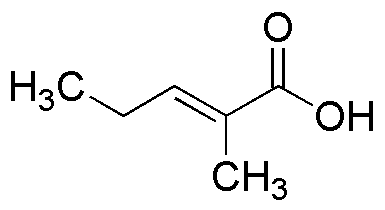2-Methyl-2-pentenoic acid is widely utilized in research focused on:
- Organic Synthesis: This compound serves as a valuable intermediate in the synthesis of various organic molecules, allowing chemists to create complex structures efficiently.
- Polymer Production: It is used in the production of specialty polymers, enhancing properties like flexibility and durability, which are crucial in industries such as automotive and packaging.
- Flavor and Fragrance Industry: The compound acts as a building block for flavoring agents and fragrances, providing unique scents and tastes that are sought after in food and cosmetic products.
- Agricultural Chemicals: It finds applications in the formulation of agrochemicals, contributing to the development of effective herbicides and pesticides that improve crop yields.
- Pharmaceuticals: This acid is involved in the synthesis of pharmaceutical compounds, offering pathways to create drugs with improved efficacy and reduced side effects.
General Information
Properties
Safety and Regulations
Applications
2-Methyl-2-pentenoic acid is widely utilized in research focused on:
- Organic Synthesis: This compound serves as a valuable intermediate in the synthesis of various organic molecules, allowing chemists to create complex structures efficiently.
- Polymer Production: It is used in the production of specialty polymers, enhancing properties like flexibility and durability, which are crucial in industries such as automotive and packaging.
- Flavor and Fragrance Industry: The compound acts as a building block for flavoring agents and fragrances, providing unique scents and tastes that are sought after in food and cosmetic products.
- Agricultural Chemicals: It finds applications in the formulation of agrochemicals, contributing to the development of effective herbicides and pesticides that improve crop yields.
- Pharmaceuticals: This acid is involved in the synthesis of pharmaceutical compounds, offering pathways to create drugs with improved efficacy and reduced side effects.
Documents
Safety Data Sheets (SDS)
The SDS provides comprehensive safety information on handling, storage, and disposal of the product.
Product Specification (PS)
The PS provides a comprehensive breakdown of the product’s properties, including chemical composition, physical state, purity, and storage requirements. It also details acceptable quality ranges and the product's intended applications.
Certificates of Analysis (COA)
Search for Certificates of Analysis (COA) by entering the products Lot Number. Lot and Batch Numbers can be found on a product’s label following the words ‘Lot’ or ‘Batch’.
*Catalog Number
*Lot Number
Certificates Of Origin (COO)
This COO confirms the country where the product was manufactured, and also details the materials and components used in it and whether it is derived from natural, synthetic, or other specific sources. This certificate may be required for customs, trade, and regulatory compliance.
*Catalog Number
*Lot Number
Safety Data Sheets (SDS)
The SDS provides comprehensive safety information on handling, storage, and disposal of the product.
DownloadProduct Specification (PS)
The PS provides a comprehensive breakdown of the product’s properties, including chemical composition, physical state, purity, and storage requirements. It also details acceptable quality ranges and the product's intended applications.
DownloadCertificates of Analysis (COA)
Search for Certificates of Analysis (COA) by entering the products Lot Number. Lot and Batch Numbers can be found on a product’s label following the words ‘Lot’ or ‘Batch’.
*Catalog Number
*Lot Number
Certificates Of Origin (COO)
This COO confirms the country where the product was manufactured, and also details the materials and components used in it and whether it is derived from natural, synthetic, or other specific sources. This certificate may be required for customs, trade, and regulatory compliance.


